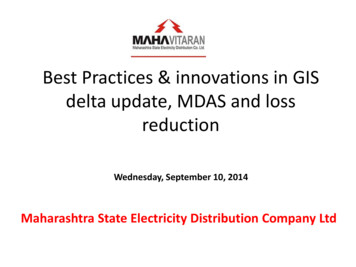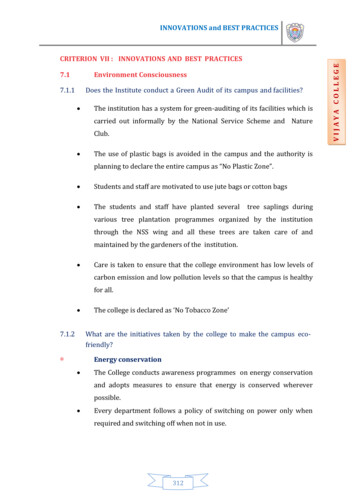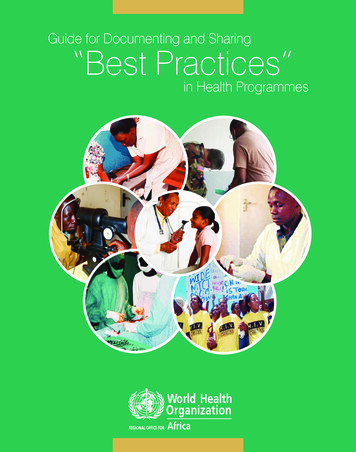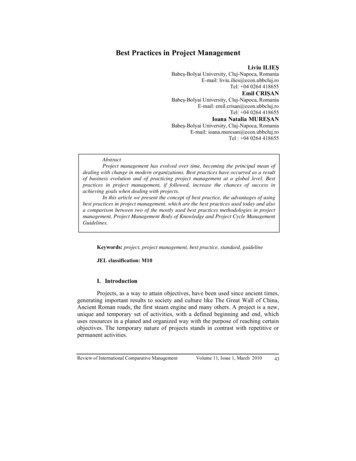
Transcription
Best Practices & innovations in GISdelta update, MDAS and lossreductionWednesday, September 10, 2014Maharashtra State Electricity Distribution Company Ltd
RAPDRP rgyAudit/NDMCRMGISInternetWeb Portal(WSS)NetworkAnalysisIdentity AccessManagementIntegration igenceMPLSCloudEMS/NMSCommunication NetworkJuno device tocapture coordinatesKioskMDASGIS DeltaUpdate/MDSIT Infrastructure at1579 offices
Go-Live Process:Challenges and StrategiesChallengeStrategy /Best PracticeAwareness1.2.3.4.Project kick-off meetings arranged upto town levelInitiatives taken by management for awareness drivesContinuous interaction with all stakeholdersTimely Completion of trainingsChange Adoption1.2.3.4.Project Charter and its adherenceMandatory Usage of R-APDRP SolutionRigorous track on usageDisciplinary actions against non compliancesData UpdateContinuous Delta Updates/Regular updates in all application databefore and after full roll outAccountability &CoordinationAccountability of Field Officers/Town In-charge for coordination withagencies for meeting Go Live requirementsPerformance of ITIA1.2.Day to day Monitoring and weekly reviewsTimely readiness for Roll Out requirements: Meters, Site readiness,Approvals, IT Infra etc.
GIS Best PracticesThe GIS (Geographical Information System) module forms an integral part of RAPDRP Software ecosystem. System Development: A core team of IT and Electrical Engineers both from HO & Field was formed. Detailed verification of the AS-IS and TO-BE documents by the core teambefore approval informed to ITIA. Like other RAPDRP applications, the Web based GIS application can only beaccessed through Single Sign On (SSO) feature. The town user can view/editGIS data related to his town, only. Additional dummy fields were reserved in GIS Data model for futurerequirements (the Data Model has fields mentioned in the RFP and MSEDCLspecific requirements). GIS system is seamlessly integrated with other applications. In the New Connection module, technical feasibility & DTC load profile is calculated by GISsystem The Energy Audit Module considers billed consumption of only those consumers who are in GIS. Disconnection & Dismantling module integrated with GIS for generating shortest route map ofdefaulters.
GIS Best PracticesPre-Survey: Workshop of agencies conducted before the survey. Were told to keep GIS survey limited to the information significant to MSEDCL.Proper Id Cards issued to the agency persons conducting the survey. Process defined for Consumer Indexing & Asset mapping and made mandatorySurvey/Managed Data Services: Consumer Indexing & Asset Mapping is done by ITIA/MDS agency as per theprocess approved by MSEDCL. For a faster GIS update, New Connection module is designed to add NewConsumers from R-APDRP towns to the GIS database directly withoutopening the GIS web application window. Managed Data Services Agency then undertakes Survey of these New Consumers and bringdetails such as Building ID, Pole ID, Coordinates, etc MSEDCL town in charge verifies the location specific details of New connections such as PoleId, DTC-code etc and with the help of the MDS agency directly update into GIS system.
GIS Best PracticesPost Survey:– Survery done by ITIA/MDS agency verified & approved by respective town incharge Surveyed GIS data is regularly verified with the billing data & in case of discrepancythe same is communicated to the ITIA/MDS agency.– Third party quality assurance of digitized GIS data was done (M/s Indycos). Correctionssuggested were verified by town incharge & corrected by MDS agency.System Operations:– Specific Responsibilities were entrusted to Town Officers vide the GIS responsibilitymatrix. The town in charge was made responsible for town level GIS activitiesincluding updation of day to day changes of network and consumers in GIS.– MSEDCL has adopted policy to release payments to vendors only after Town GISdata viz. Sub Station, Feeder or Transformer data is visible in GIS application.– Network Augmentation Schemes are prepared using the GIS based NetworkAnalysis Module.
GIS MANAGED DATA SERVICESDELTA- GIS Data gap between start of GIS survey & digitization process of the Town by ITIAandthe Go-live of Data Center & R-APDRP modules (when GIS updates can be donedirectlythrough R-APDRP systems)Why? : Need of dedicated resources to cater to delta update process requirements.Insufficient Field Staff and lack of skill of GIS data collection and Update.Handholding training to MSEDCL staff by skilled resources required.Importance of Timely update of GIS data.Solution: Outsourcing Managed Data Services (MDS) by hiring dedicated trainedmanpower for Town activities and GIS experts for DC activities onService Level Agreement (SLA) basis.Post Go-live, MSEDCL has appointed an independent third party Managed Data ServicesAgency (M/s ADCC Infocad Pvt Ltd) for helping MSEDCL staff to carry out GIS delta update andregular update work and training/handholding.
GIS Update AchievementsSubstationFeedersDTCHT ConsumersCross 5298554191329570625198SubstationsITIA87.03%MDSHT ConsumersMDS3215401764131ITIA87.69%MDS19.27 %Crossovers17.65%ITIA12.31 %ITIAITIATOTALDTC12.97%86.55%MDS3180082 758848Feeders13.45%MDSLTCONSUMERS28.08 %ITIA82.35%LTConsumersMDSITIA71.92 %MDS80.73 %ITIA Delta update completed at 120 towns. 117 Towns are declared Go-liveMDS
Key Challenges faced/being faced for MDS implementation Rapid changes in network due to new consumeradditions and creation of new electrical infrastructureunder RAPDRP Part ‘B’. Low awareness and availability of MSEDCL users forMDS activities resulted into little delayed results. Improper connectivity was a demotivating factor. Coordination between ITIA and MDS agency.
Impact of Managed Data Services MSEDCL field staff learnt the process of GIS & GISupdate. CCCC services improved because of proper indexing Accuracy in Network Analysis R-APDRP application issues (GIS, EA, MBC, etc) areproperly identified and immediately resolved;
Best Practices - MDASAutomated Meter Reading(AMR) System is implemented for High Tension Consumer, Feeder Metersand Distribution TransformerMDAS Software The MDAS software (API Caller module) is developed & maintained in-house by MSEDCL. Therefore enhancements to the software (based on user feedback) are done to the software almostimmediately. To utilize the software and resources fully and to get the maximum benefits MSEDCL has extended use ofthis application to non-RAPDRP areas also.Standardization Process of healthy metering infrastructure (meter, CT, cable, meter box) is defined. All the meters are set in MD Auto Reset Mode. RS232 port pin configuration was standardized.Reachability Services from Multiple service providers (viz. Reliance Communications, Vodafone, Airtel, TataTeleservices) are being used. Service providers having connectivity in a particular area are preferred forincreasing meter-modem read count.Approach For successful implementation of AMR : AMR Responsibility Charter is prepared Progress of MDAS is reviewed at various levels. Approx. 35,000 Meters are read successfully every month 10705 HT Consumers Meters read successfully in month of AUG-14 and bills are issued
Best Practices - MDASHT CONSUMERS BILLED AS PER MDAS READINGS1200010000HT CONSUMERS80006000400020000
Loss reduction: Best Practices &Innovatory efforts Every year approx. 5% meters get faulty (ie. Approx. 11 lakh meters) & are replaced Meter-infrastructure/reading related issues:–Under-billing due to old electromechanical & faulty meters form a major part of the distribution losses.–Erroneous meter reading due to human intervention (manual meter reading) Replacement of these meters as one of the measure to reduce losses has proved tobe the most effective one. MSEDCL realized that to reduce losses and increase demand, existing meteringinfrastructure needs to be strengthened. Therefore, MSEDCL has adopted new metering technologies such as Meters with InfraRed (IR) ports, Meters with Radio Frequency (IR) Ports & AMR enabled meters.IR , RF Meters and Development of Common Protocol : IR port meters for Low Tension consumers in scattered (mostly rural) areas and toinstall RF port meters in densely populated (mostly urban) areas Protocols were developed in-house by MSEDCL and made mandatory for all themanufacturers bidding for the tender. Due to common protocol it is possible to catch readings of different makes of IR or RFmeters using the same hand held device.
Loss reduction: Best Practices &Innovatory efforts Accordingly till date, 37.93 lakh IR and 7.21 lakh RF meters have been installed in MSEDCL. In the year 2013-2014, MSEDCL has observed 22% rise in the sale and demand compared toprevious year & which can be attributed to the renovation of metering infrastructure using newmetering technologies. Necessary actions are taken on regular basis on the following exceptional reports generated bythe system,– Consumers billed on Average (Locked/Faulty),– Consumers billed as per RNA/RNT– Consumers billed in the range 0 to 30 units The meter reading program cycles are scheduled as per the schedule of feeder meter readings tominimize approximation in Energy Audit.All possible care is taken to keep the feeder load, transformer load & transformer phase balanced. New connections released are fed & monitored through the New connection system and billingof these consumers is timely started , thereby avoiding delay in issue of first bill to the consumers.This eventually lead to minimising unbilled new connections, thereby reducing distribution losses.
ITIA MDS ITIA MDS ITIA MDS ITIA MDS ITIA MDS ITIA MDS ITIA MDS 341 53 1577 235 29855 4191 3295 706 251 98 3180082 758848 3215401 764131 GIS Update Achievements ITIA MDS Feeders 87.03% 12.97% ITIA MDS DTC 87.69% 12.31 % ITIA MDS HT Consumers 82.35% 17.65% ITIA MDS 80.73 % 19.27 % LT CONSUMERS ITIA MDS Crossovers 71.92 % 28.08 % Delta update .











